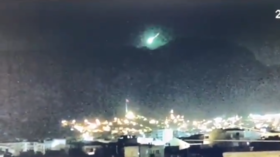Green meteor buzzes Turkey’s Izmir, prompting rumors of rocket debris and SATELLITE falling from the sky (VIDEOS)

A green-tinted meteor has been spotted near the Turkish city of Izmir, falling in the mountains with a loud bang. The occurrence sent shockwaves through social media, eliciting wild rumors.
The meteor fell to Earth early on Saturday, its path captured on film by a number of people. Its descent was reportedly followed by a loud, explosion-like bang.
Gece saat 01:30 dan saat 02:45 arası izmir ve manisaya meteor ateş topu ihbarı geldi. Görüntü yangın harekattan. pic.twitter.com/mzLwuvWd1l
— KILIÇ⭐⭐⭐⭐⭐1907 (@jacob__1907) July 31, 2021
Footage circulating online shows the meteor had a greenish tint that lit up the night sky. It wasn’t immediately clear whether it had actually reached the ground or fully disintegrated mid-descent.
Uzaylılar size sesleniyorum. Siz de gelin tam olsun...#meteor#izmirpic.twitter.com/GrSiNUwxjc
— Halil İbrahim Çakan (@h_ibrahimcakan) July 31, 2021
Its unusual color prompted the wildest rumors online, with some users believing it was a piece of rocket debris. Others suggested it was a depreciated satellite that had fallen out of its orbit.
The associate director of the Aegean University Observatory, Dr. Hasan Ali Dal, came up with a much more mundane and likely explanation for the occurrence, however. The scientist told local media the object was part of a meteor shower that began ‘raining’ over Earth last week and will continue to do so until the end of next month.
“The Perseid meteor shower, which started on July 24, will continue until August 24. The number [of meteors] will increase in the coming days,” he stated.
The shower, which occurs every year, is associated with the cloud of dust and larger particles emitted by its parent comet, Swift-Tuttle. It usually peaks around August 11, with some 50 meteors per hour observed at that point. The objects are rarely large enough to reach the ground, however.
Also on rt.com More than 5,000 tons of extraterrestrial dust rain down on Earth each year, new research saysThe green tint of the Izmir meteor has a simpler explanation, too. The color of its trail likely stems from its chemical composition, signaling that it contains large amounts of nickel.
Think your friends would be interested? Share this story!













